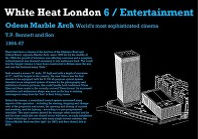White Heat London
Sixty years ago, Britain’s science and technology led the world. Extending her wartime leads in radar, aerodynamics and computing whilst also exploring new fields had yielded remarkable successes in the first years of peace. British firm Ferranti built the world's first commercially-available computer, based on a Manchester university prototype, in 1951. Working with American biologist James Watson, English physicist Francis Crick discovered the double helix structure of the DNA molecule in 1953. Bernard Lovell constructed the Mark I radio telescope at Jodrell Bank in 1957, using actual war surplus materials. And Christopher Cockerell conceived the hovercraft, an invention deemed so important that it was classified until 1959 when the first example could finally be unveiled. All of this was achieved despite the economic impact of a global conflict, and aligned with a widespread feeling of progress and optimism buoyed by a national festival and the accession to the throne of a new young queen.
As the country moved confidently into the next decade, the mood was captured by Prime Minister Harold Wilson’s speech to the Labour Party conference in 1963 when he talked of a new Britain “forged in the white heat of this revolution”. Its foundries were scattered across the country but in London especially, state-of-the-art engineering came together with new architectural and design solutions to create daring, stylish and modern projects both public and private that brought improvements to many aspects of life.
A few, like the slim concrete shaft of the Post Office Tower and the Underground’s automatically-operated Victoria line, are well known, together with the innovation they represented. Others are familiar sights but not widely recognised for their impressive advances, whether at Europe’s most sophisticated cinema or Fleet Street’s newest premises. And many are hidden gems, from a High-Tech ‘shed’ anticipating the Docklands boom by a dozen years to a multi-storey urban workshop built half a century before today’s concern with accommodating the capital’s makers locally.
Some have not survived but all are a cause for celebration and so the White Heat London series does exactly that, with a monthly download summarising a key project of this exciting decade - click the 'buttons' below. For each, a two-page pdf has concise text, a contemporary technical illustration and three carefully-chosen images, all in a period-appropriate style. Issued in chronological order of completion throughout this year, they will highlight British achievement that has been overlooked and which laid the groundwork for today’s fast-paced, digitally-enabled world.
To obtain an exclusive bonus article linking the first project and the second, simply get in touch via the ‘Contact’ tab
07 The Victoria line
Fast, smooth, automated and convenient Tubes:
08 Emanuel House
Automatic car park, computer
suite, flats and more:
09 Euston station
Long-distance rail travel for
the motorway and airport era:
10 Greenwich District Hospital
Mechanised, planned, with separated service floors:
11 West Central District Office
The Royal Mail's new post
processing plant:
12 Fred. Olsen amenity building
A High-Tech docklands gem years before its time:










01 BBC Television Centre
Starting the decade with a
state-of-the-art complex:

06 Odeon Marble Arch
The smartest, coolest cinema in
the world:
05 Central House
Local, urban factory space,
stacked and shared:
02 Daily Mirror building
A 'red top' gets a red building with
a ground-breaking structure:
04 Post Office Tower
The great and glorious tallest
building in Britain:
03 West London Air Terminal
Book a flight by phone then check
in, relax and await your... bus:
________________________________________________________
Posted 15 January - 15 December 2020
